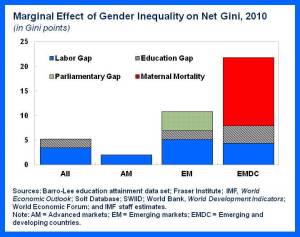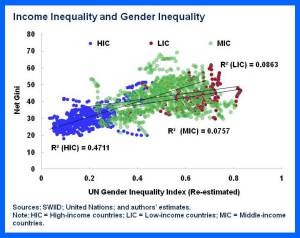Why gender and income inequality are linked

Despite progress, wide gaps between women and men’s economic empowerment and opportunity remain, which policymakers need to tackle urgently. In most countries, more men than women work, and they get paid more for similar work. Also, there are considerable gender gaps in access to education, health and finance in a number of countries. There is mounting evidence that the lack of gender equity imposes large economic costs as it hampers productivity and weighs on growth.
Our new study analyzes the links between these two phenomena—inequality of income and that of gender. We find that gender inequality is strongly associated with income inequality across time and countries of all income groups.
Gender and income inequality are linked
There are at least three reasons why higher gender inequality is associated with higher income inequality:
- First, gender wage gaps directly contribute to income inequality, and higher gaps in labor force participation rates between men and women result in inequality of earnings between sexes, thus creating and exacerbating income inequality.
- Second, women are more likely to work in the informal sector, in which earnings are lower, which widens the gender earnings gap and exacerbates income inequality.
- Finally, inequality of opportunities, such as unequal access to education, health services, and finance are prevalent between men and women, and are strongly associated with income inequality.

The evidence
Our study finds that gender inequality is strongly associated with income inequality across time and countries of all income groups, even after controlling for the standard drivers of income inequality, which include financial openness and deepening, technological progress and labor market institutions. We study the association between the two phenomena for almost 140 countries over the last two decades. Our study extends the United Nation’s Gender Inequality Index, which captures both gender inequality in outcomes (labor force participation gap and share of female seats in parliament) as well as gender inequality in opportunity (education gaps, maternal mortality, and adolescent fertility).
Our main finding is that an increase in this multi-dimensional index from zero (perfect gender equality) to one (perfect gender inequality) is associated with an increase in net income inequality (as measured by the Gini coefficient) of almost 10 points.
While these results hold for countries across all levels of development, the relevant dimensions of gender inequality vary. For advanced countries—with largely closed gender gaps in education and more equal economic opportunities across sexes—income inequality arises mainly through gender gaps in labor force participation. In emerging markets and low-income countries, inequality of opportunity, in particular in gender gaps in education and health, appears to pose an obstacle to a more equal income distribution.

The evidence suggests that greater gender equity and increasing female economic participation are associated with higher growth, more favorable development outcomes, and lower income inequality. Given these strong associations, aspiring to equality of opportunities and removing legal and other obstacles that prevent women from reaching their full economic participation becomes an issue of macroeconomic relevance, on top of the strong human rights argument: A more level playing field would give women the option to become economically active should they so choose. This in turn would have beneficial macroeconomic effects.
Policy makers should take multi-pronged approach
A significant decrease in gender gaps will require work along many dimensions. The policy recommendations have been discussed in previous IMF work on gender and include:
- Remove gender-based legal restrictions. Gender-related legal restrictions are prevalent in a number of countries and include legal impediments to women undertaking economic activities. Previous work has found that equalizing laws boosts female labor force participation. Specifically, granting gender equity under the constitution could increase the female labor force participation by as much as 5 percent.
- Revise tax policies. Fiscal disincentives for secondary earners can limit female participation, and are viewed as an important barrier in Germany. Replacing family-based taxation with taxation of individual incomes would eliminate disincentives for secondary earners, who are frequently women. This could encourage more women to join the labor force.
- Create fiscal space for priority expenditures such as on infrastructure and education. In developing economies, better infrastructure in rural areas—for example, more access to water and improved transportation systems—can reduce the time women spend on domestic tasks and enable them to seek work outside the home. Evidence from India suggests that female labor force participation in India would rise by 2 percentage points with an increase in spending on education of 1 percent of GDP.
- Implement well-designed family benefits. Better access to parental leave and high quality, affordable childcare will make it easier for women to seek employment. In order to boost female force participation in Japan, a number of measures have been put in place including expanding childcare leave benefits from 50 percent to 67 percent of salary and boosting childcare services by around ½ million children by April 2015.
Redistribution is complementary to these gender-based policies
Nothing can substitute for gender-specific policies geared to reducing gender and income inequality. Previous IMF work has shown that redistribution generally has a benign effect on growth, while lowering lower income inequality. However, in order to combat deeper inequality of opportunities, such as unequal access to the labor force, health, education and financial access between men and women, policy markers should focus on more targeted policy interventions.
This article is published in collaboration with IMF Direct. Publication does not imply endorsement of views by the World Economic Forum.
To keep up with the Agenda subscribe to our weekly newsletter.
Author: Sonali Jain-Chandra is a Deputy Division Chief in the IMF’s Asia and Pacific Department. Kalpana Kochhar is currently a Deputy Director in the Strategy, Policy and Review Department of the IMF. Monique Newiak is an Economist in the Regional Studies Division of the IMF’s African Department.
Image: A Businesswoman is silhouetted as she makes her way under the Arche de la Defense, in the financial district west of Paris. REUTERS/Christian Hartmann.
Don't miss any update on this topic
Create a free account and access your personalized content collection with our latest publications and analyses.
License and Republishing
World Economic Forum articles may be republished in accordance with the Creative Commons Attribution-NonCommercial-NoDerivatives 4.0 International Public License, and in accordance with our Terms of Use.
The views expressed in this article are those of the author alone and not the World Economic Forum.
Stay up to date:
Future of Work
Related topics:
Forum Stories newsletter
Bringing you weekly curated insights and analysis on the global issues that matter.
More on Equity, Diversity and InclusionSee all
Marielle Anzelone and Georgia Silvera Seamans
October 31, 2025







